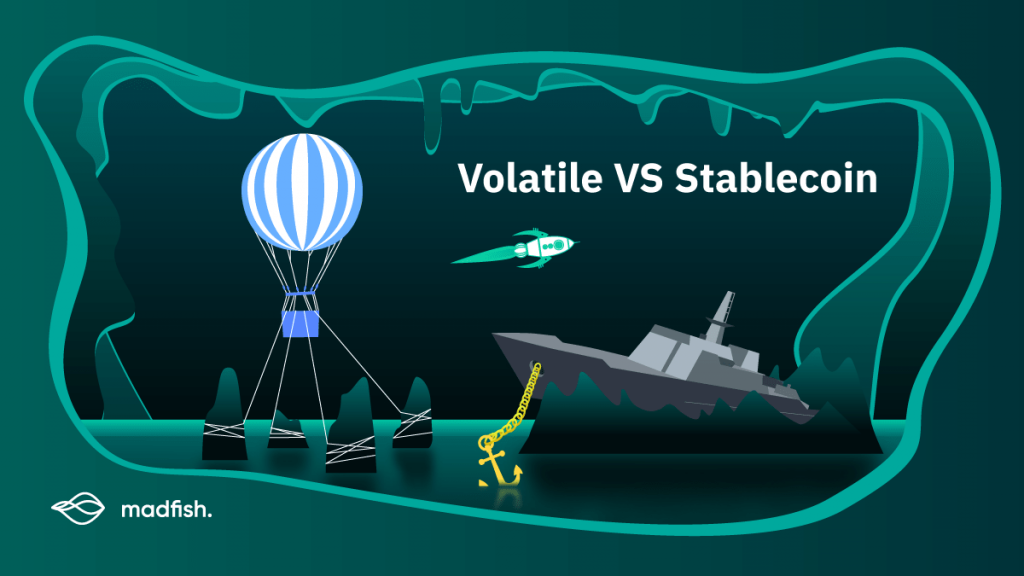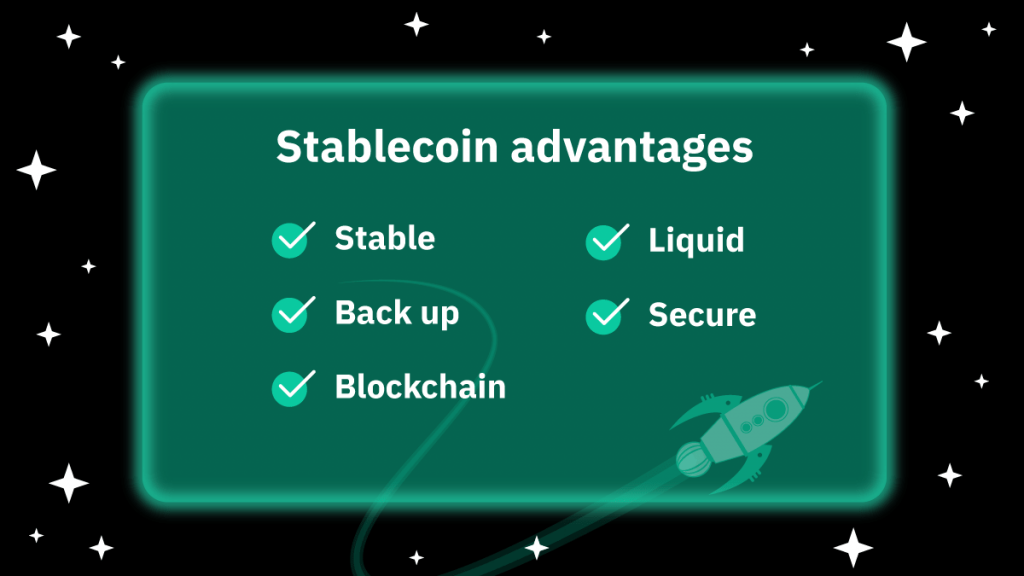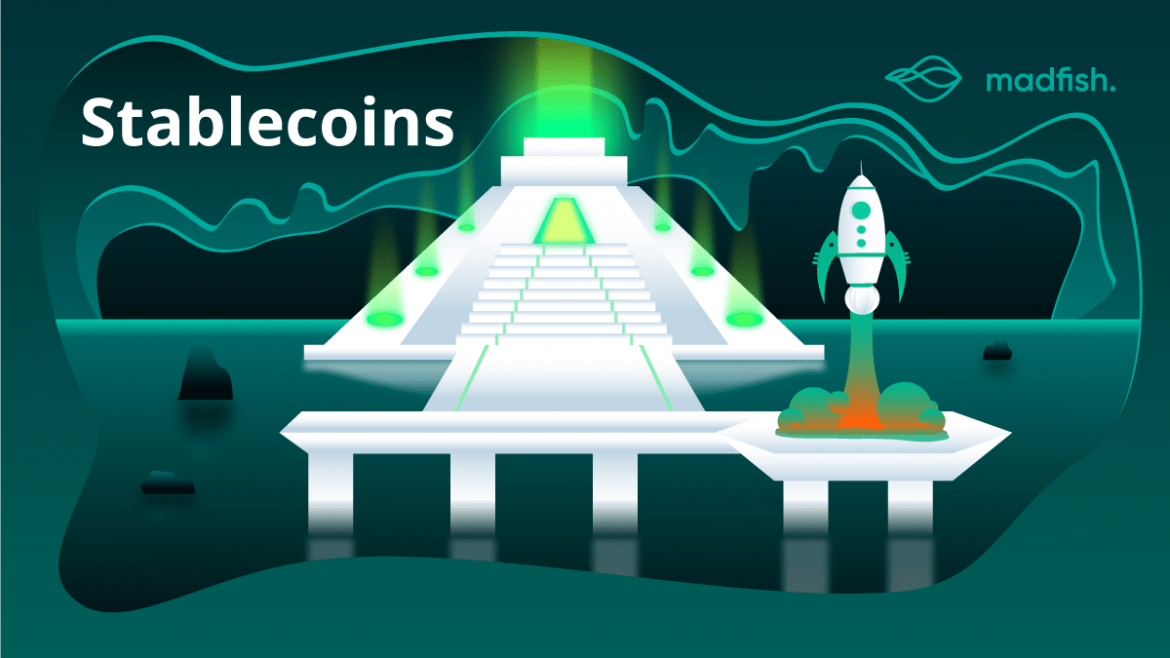When you start dealing with cryptocurrencies, you’ll inevitably encounter the term “stablecoin”. Its meaning is pretty straightforward: it’s a coin whose value is linked to a stable asset (usually, the US dollar or gold). How is this technologically possible and how can we use these tokens? Read this guide for the answers.
Stablecoins vs. Volatile coins: What’s the difference
You may think that a stablecoin guarantees certainty — but the stability behind this token is illusory. A stablecoin’s price is not set and then fixed forever, and it may turn out to be a shitcoin that doesn’t have any real value. However, compared to volatile cryptocurrencies whose values can increase by 500% and then crash, all within a year, stablecoins bring more predictability to the fast-changing crypto world. They retain their purchasing power and minimize the chance of inflation. This is possible due to the stable valuation of their underlying asset or their external reference.

How stable is a stablecoin
The stability of a stablecoin depends on the stability of its reserve asset. Any problem with the underlying asset affects the token. For example, most stablecoins linked to gold appear to be shitcoins and, once pegged to a fiat currency, become much more reliable. Their stability is still questionable though. For example, it’s unlikely that Tether USD is fully backed up by its reserve fiat currency. As Financial Times observers pointed out, the 2021 report on Reserves Breakdown shows that only 2.9% of Tether USD is backed by cash. Nevertheless, this cryptocurrency still had the greatest market capitalization at the end of May 2021.
Top 5 stablecoins (by May 28, 2021)
Tether USD. The first, and most widely used, stablecoin linked to the US dollar. Market Cap: $61,212,475,876.
USDC. Market Cap: $21,985,351,100.
BUSD. Market Cap: $8,707,435,946.
Terra USD. Market Cap: $1,967,071,673.
DAI. The most popular crypto-backed stablecoin popularized by MakerDAO. Market Cap: $453,161,226.
3 methods of making a stablecoin
1. Linked to a set up “reserve”: In most cases, the entity, being an individual custodian, creates an asset reserve to secure a stablecoin. That’s how the peg to a fiat currency is created: one million US dollars back up one million dollars worth of a linked stablecoin. Alternative collateral reserves can be commodities or precious metals. A 100% reserve appears to be an ideal scenario, however, the above-mentioned case of Tether USD provides more clarity on this.
2. Collateralized by other cryptocurrencies: If another cryptocurrency covers the stablecoins, overcollateralization is needed to protect them from volatility. Maker’s DAI is the most illustrative case here. This stablecoin has 150% support from Ether (ETH), a native cryptocurrency for Ethereum blockchain.
3. Algorithmic methods: Algorithms and smart contracts manage the token supply – depending on the price fluctuations, they are either burned (to increase their value) or more are created (to decrease their price). However, experiments with algorithmic stablecoins have not been successful to date. Basis stablecoin, the most popular token of this type, had an underlying consensus mechanism on controlling the supply. Nevertheless, the project was closed due to governmental regulatory constraints.
Basis stablecoin, the most popular token of this type, had an underlying consensus mechanism on controlling the supply. Nevertheless, the project was closed due to governmental regulatory constraints.
The technical side of making stablecoins
Stablecoins possess the basic traits of cryptocurrencies:
- Blockchain-based (most popular stablecoins are Ethereum-based ERC-20 tokens)
- No central bank involved
- Transacted peer-to-peer
- Censorship-resistant
But how is it possible to build a link with an underlying asset? The technical specifics differ according to the methods. In the case of a set-up, off-chain reserve, the centralized entity holds the collateral and issues stablecoins. Regular audits ensure trustworthiness, and token redemption is the issuer’s responsibility.
Cryptocurrency-backed stablecoins use the basket of crypto-assets as collateral. This results in the presence of smart contracts that regulate the reserve protection for the stablecoin. In DAI’s case, there exist publicly visible reserves that are decentralized and relatively stable, thanks to sufficient overcollateralization. In this way, the supply of stablecoins depends on the underlying asset’s size.
The approach to creating algorithmic stablecoins involves supply calculations based on the current trade. If the price falls below $1, coin holders are encouraged to purchase bonds (a separate token class). The coins spent are then burned to decrease their supply and increase their price. If the price increases above $1, extra tokens are minted and distributed among separate token classes.
Advantages of stablecoins

- Back up mechanism: Stablecoins have a stable asset or a clear algorithm behind them.
- Minimized price volatility: Stablecoins ensure the value and satisfy the need for a safe coin on the blockchain.
- Blockchain-based: Possess all the advantages of cryptocurrency even when linked to fiat currency.
- Liquidity: Can be used in cryptocurrency exchanges.
- Secure: Stablecoins can be used for transactions and entering into the crypto market.
Risks of using stablecoins
- Price fluctuation: The cryptocurrency can still fluctuate against its reference asset, especially if it is crypto-collateralized.
- Insufficient backup transparency: In the case of centralized entity-issued stablecoins, it’s hard to trust a custodian. The supply of stablecoins can be manipulated, as has happened in the past to Tether USD.
- Risk of hacks: Stablecoins are blockchain-based and vulnerable to hacks and crashes.
Here is a good explanation video about the risks of using stablecoins on the Iron example:
How to use stablecoins in a lending protocol
In most cases, you’ll receive stablecoins as borrowing assets in a lending protocol. You can use them in your long- and short-term investment strategies, or take advantage of the price increases or decreases of a volatile cryptocurrency asset. In this case, you should always keep an eye on the sufficient overcollateralization of your debt — otherwise, the liquidation process can take place.
Some platforms provide the opportunity to deposit stablecoins. Depending on the platform, you can receive around 10-20% interest. In this way, a stablecoin can serve as an easy entry-point to understand, learn how to make profit, and trade in the cryptomarket.
Remember: whichever investment decision you make, always do your independent research first!
Useful links:
You can find out more about the oracles that are involved in the issuing of stablecoins in this article.
The review of Kolibri, a decentralized protocol for issuing stablecoins in the Tezos ecosystem, is available here.
What other DeFi platforms allow using lending protocols? Read our rating.

